- About
- Admissions
- Study at AUS
- Prospective Students
- Bachelor's Degrees
- Master's Degrees
- Doctoral Degrees
- Admission Publications
- International Students
- Contact Admissions
- Grants and Scholarships
- Sponsorship Liaison Services
- Testing Center
- New Undergraduate Student Guide
- New Graduate Student Guide
- File Completion
- New Student Orientation
- Payment Guide
- Executive Education
- Students with Disabilities
- Academics
- Life at AUS
- Research
- Contact Us
- Apply Now
- .
Sustainability
AUS faculty are leading and contributing to research that has benefit to the societies in which we all live. Read on to learn about the research being pursued by AUS faculty in the field of sustainability.
- Catalyzing Sustainable Innovations: AUS Professor's Work Amplifies UAE's Green Agenda and Global Transformation
-
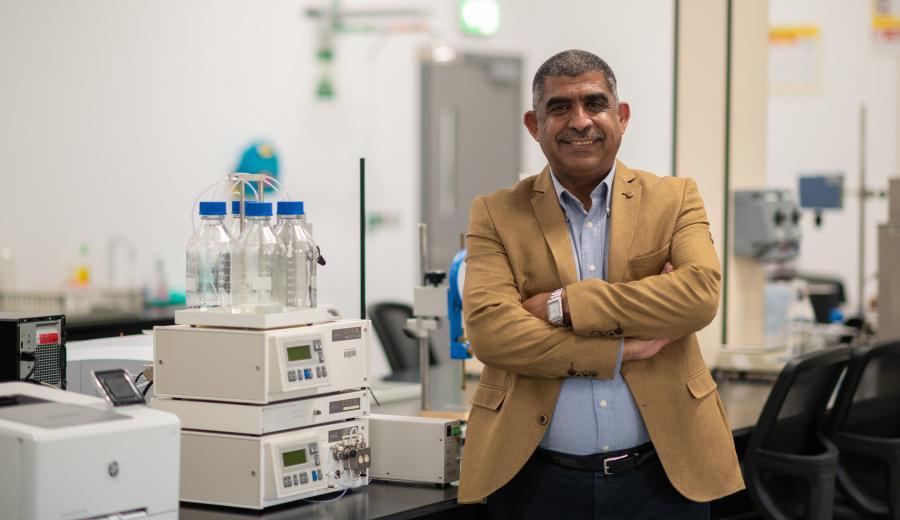
Embarking on a journey fueled by innovation, Dr. Sameer Al-Asheh, Professor and Head of the Department of Chemical and Biological Engineering at American University of Sharjah (AUS), is pioneering research that aligns not only with the UAE's quest for sustainability but also with AUS' steadfast commitment to a cleaner and greener future. Through Dr. Al-Asheh’s contributions in water treatment, renewable energy and responsible waste management, his work stands as a cornerstone driving both the nation's environmental aspirations and global development.
Click here to read more.
-
AUS Professor’s Research Endeavors Contribute to Sustainable Transformation and Innovation
-
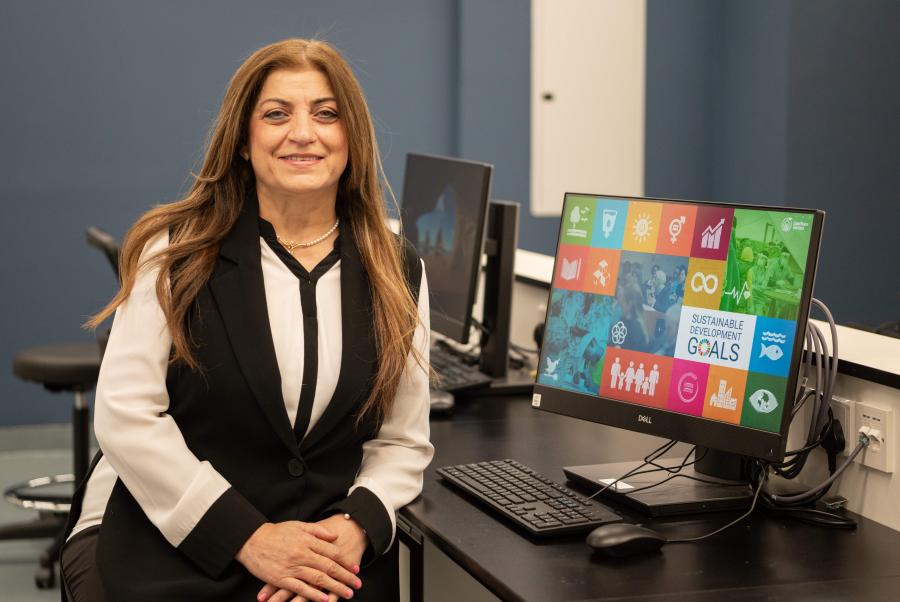
A distinguished American University of Sharjah (AUS) researcher and professor of industrial engineering, Dr. Vian Ahmed is leading research that lies at the center of AUS' unwavering dedication to sustainability. Her studies delve into the economic, environmental and social dimensions of this important field.
Click here to read more.
-
Innovative Renewable Energy Research by AUS Alumnus Wins RMIT Prize for Research Excellence
-
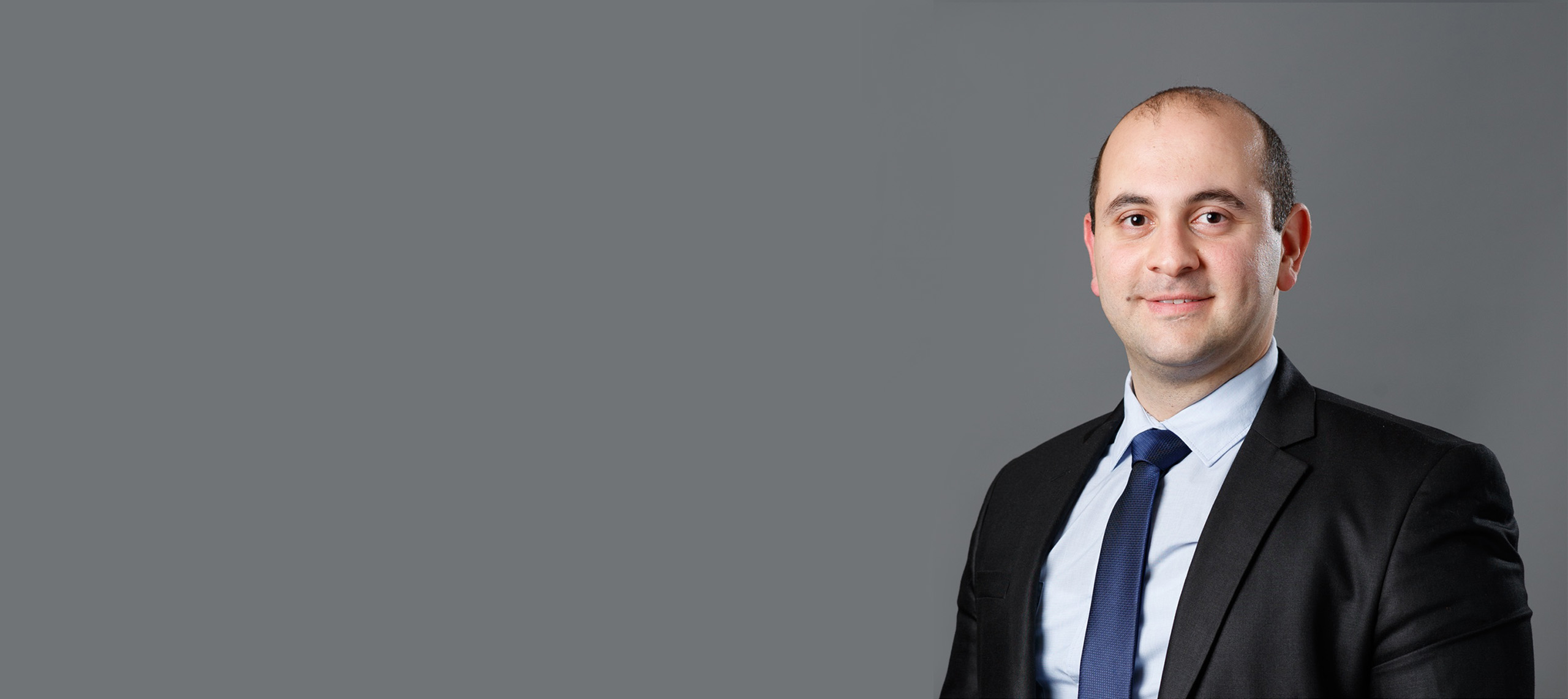
American University of Sharjah (AUS) alumnus Dr. Nameer Al Khafaf has been awarded the Royal Melbourne Institute of Technology (RMIT) Prize for Research Excellence – Higher Degree by Research Award 2022 for his research on integrating renewable energy sources into existing power grids.
Click here to read more.
-
The Forefront of Electric Vehicle and Robotic Exploration Technologies
-
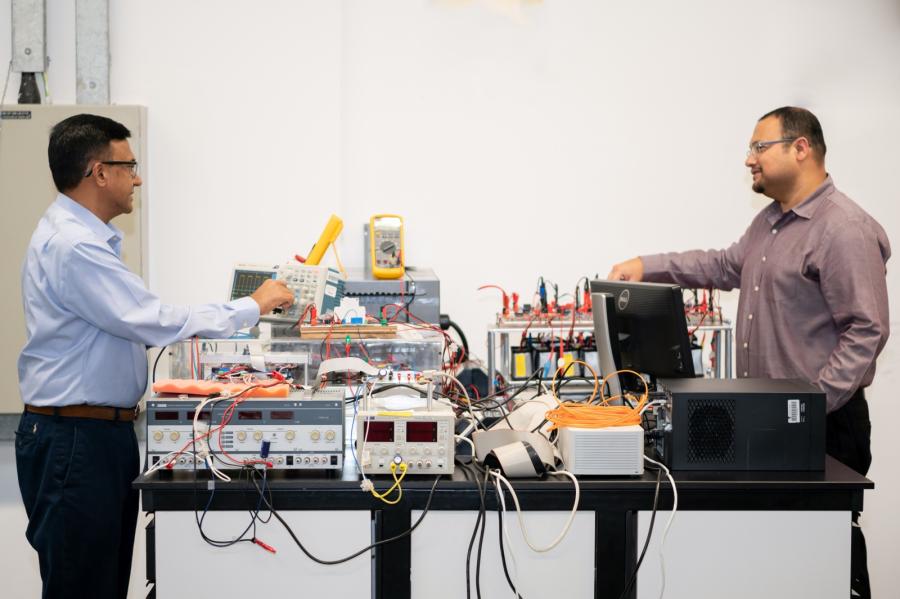
A researcher and Associate Professor of Electrical Engineering at American University of Sharjah (AUS), Dr. Shayok Mukhopadhyay, is at the forefront of unveiling new developments in the rapidly expanding fields of electric vehicle (EV) technology and robotics through his pioneering research.
Click here to read more.
- Research on Smart Cities And IoT-Based Platforms Contributes to United Nations’ Sustainable Development Goals
-
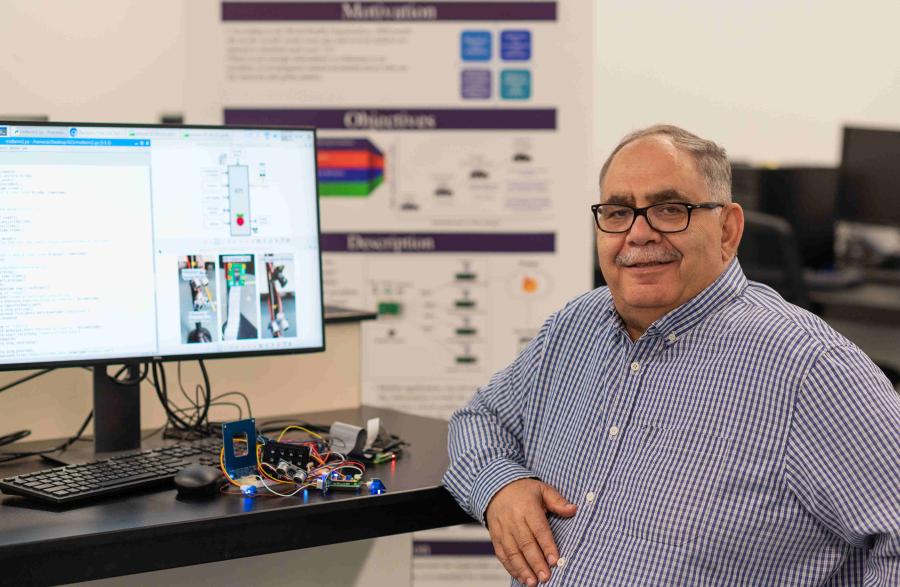
American University of Sharjah (AUS) continues its commitment to research that positively impacts society, as renowned professor and researcher Dr. Abdul-Rahman Al-Ali publishes research on smart cities applications and employing the Internet of Things (IoT), cyber-physical systems and artificial intelligence (AI) based platforms. Dr. Al-Ali is a professor in the AUS Department of Computer Science and Engineering.
Click here to read more.
-
Designing Thermal Energy Storage Systems for a More Sustainable Future
-
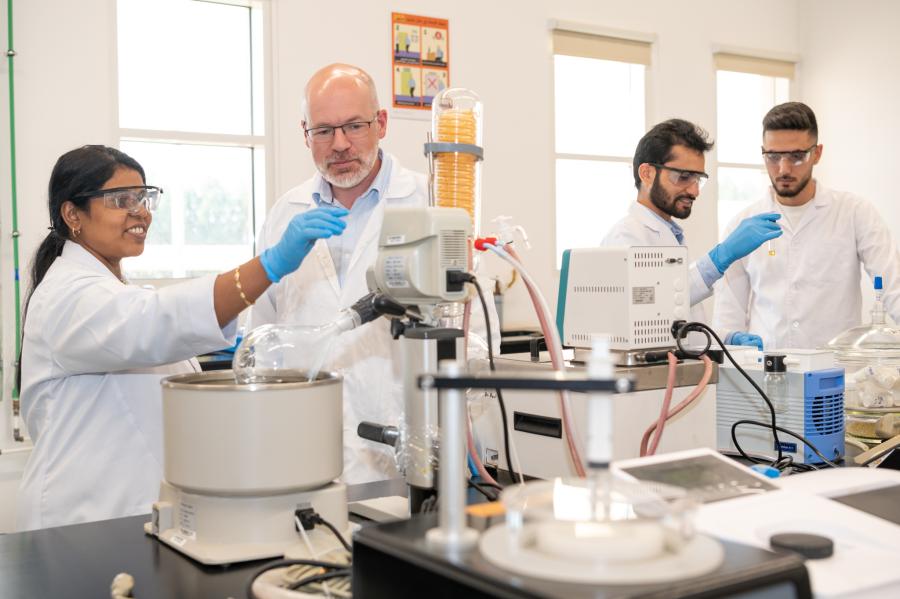 As part of American University of Sharjah’s (AUS) ongoing focus on energy and sustainability, a collaborative research team at AUS is working on designing thermal energy storage systems that will assist in the transition to renewable energy.
As part of American University of Sharjah’s (AUS) ongoing focus on energy and sustainability, a collaborative research team at AUS is working on designing thermal energy storage systems that will assist in the transition to renewable energy.“Due to environmental concerns, the world is shifting from fossil fuels towards more renewable energy sources, but unlike fossil fuels, which can be used to produce energy when required, solar and wind energy have variable supply, which makes energy storage a critical component in the transition towards clean energy. Recent improvements in battery technology have advanced energy storage capacity, but batteries also have their own issues in relation to safety and the relative scarcity of materials used in their production. This is why it is essential to use a mixture of other energy storage solutions to complement the use of batteries,” said Dr. Paul Nancarrow, Professor in Chemical and Biological Engineering and lead researcher.
Click here to read more.
-
First-of-its-Kind Study on One of the UAE’s Largest, Oldest and Most Diverse Ecosystems
-
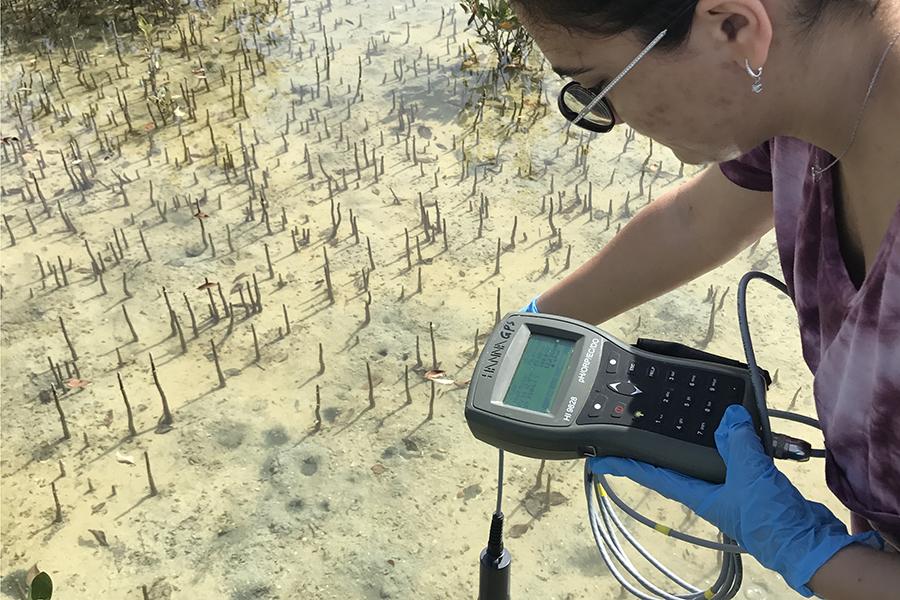 The Khor Al-Beida mangrove forest of Umm Al-Quwain, the breeding ground for the largest colony of the Socotra Cormorant bird in the Gulf region, has been deemed healthy and relatively undisturbed by human activity, according to a first-of-its-kind study conducted recently. Despite being one of the UAE’s largest, oldest and most genetically diverse ecosystems, relatively little is known about the country’s mangroves and their vulnerability to human behavior.
The Khor Al-Beida mangrove forest of Umm Al-Quwain, the breeding ground for the largest colony of the Socotra Cormorant bird in the Gulf region, has been deemed healthy and relatively undisturbed by human activity, according to a first-of-its-kind study conducted recently. Despite being one of the UAE’s largest, oldest and most genetically diverse ecosystems, relatively little is known about the country’s mangroves and their vulnerability to human behavior. Click here to read more.
-
Using IoT and Big Data to Monitor Large-Scale Distributed Solar Farms in Smart Cities
-
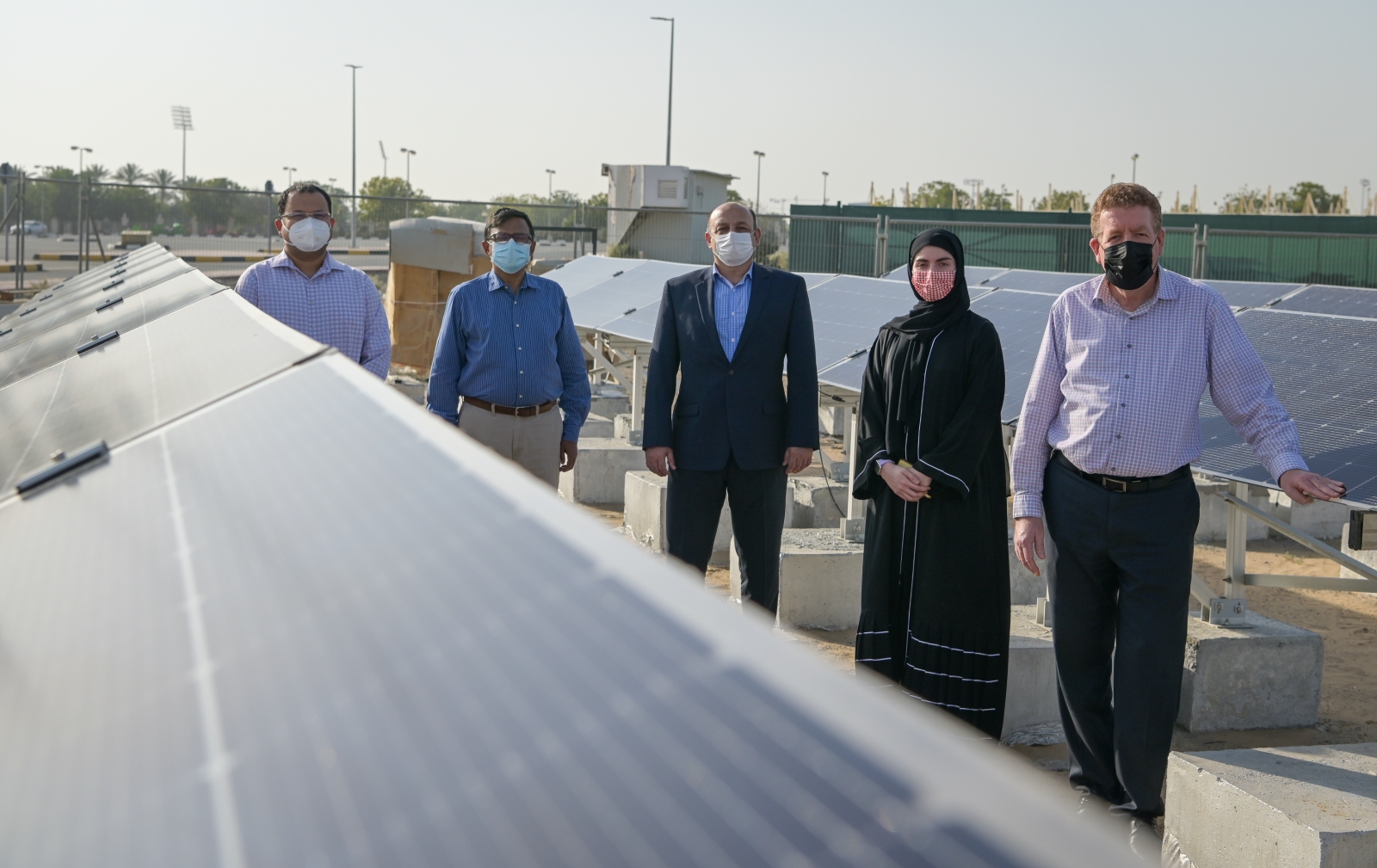 A research project currently underway at AUS is studying the performance of solar modules across the region with a view to developing a set of best practice recommendations for the installation, operation and maintenance of large-scale solar farms. The project will evaluate the transport, storage and analysis of real-time solar energy data through a big data analytics infrastructure. Data from the solar facilities included in the study will be sent over a LoRaWAN network, a relatively new form of technology when compared to other long-range technologies. This will provide an opportunity to study network performance of real-time solar energy data streaming, as well as generate recommendations for implementing applications using LoRaWAN networks.
A research project currently underway at AUS is studying the performance of solar modules across the region with a view to developing a set of best practice recommendations for the installation, operation and maintenance of large-scale solar farms. The project will evaluate the transport, storage and analysis of real-time solar energy data through a big data analytics infrastructure. Data from the solar facilities included in the study will be sent over a LoRaWAN network, a relatively new form of technology when compared to other long-range technologies. This will provide an opportunity to study network performance of real-time solar energy data streaming, as well as generate recommendations for implementing applications using LoRaWAN networks. Click here to read more.
-
AUS Researchers Develop Novel Model to Boost Solar Energy Production
-
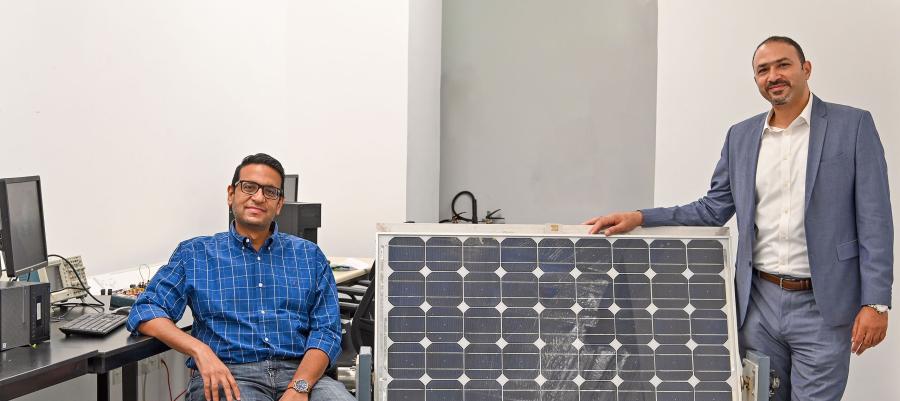 Two researchers at American University of Sharjah (AUS) have developed a novel mathematical model that determines the appropriate time to clean solar panels of dust accumulation, leading to an increase in energy generation.
Two researchers at American University of Sharjah (AUS) have developed a novel mathematical model that determines the appropriate time to clean solar panels of dust accumulation, leading to an increase in energy generation.Click here to read more.
-
AUS Study Notes Potential Impact of Changing Wave Patterns on the Arabian Gulf Coastline
-
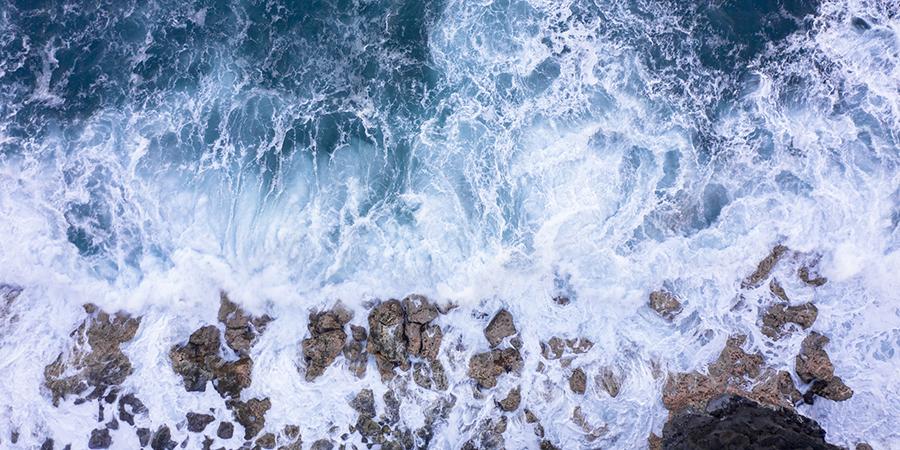 Environmental changes have been a major factor impacting the preparation and design of development and construction plans around the world. The Arabian Gulf is no different. A recent study conducted by scientists at American University of Sharjah (AUS) shows that the Arabian Gulf has undergone rapid changes over the past four decades, with noticeable increase in wave heights.
Environmental changes have been a major factor impacting the preparation and design of development and construction plans around the world. The Arabian Gulf is no different. A recent study conducted by scientists at American University of Sharjah (AUS) shows that the Arabian Gulf has undergone rapid changes over the past four decades, with noticeable increase in wave heights.Click here to read more.
-
Faculty Members from AUS and NYUAD Team up on Plastic Recycling Research
-
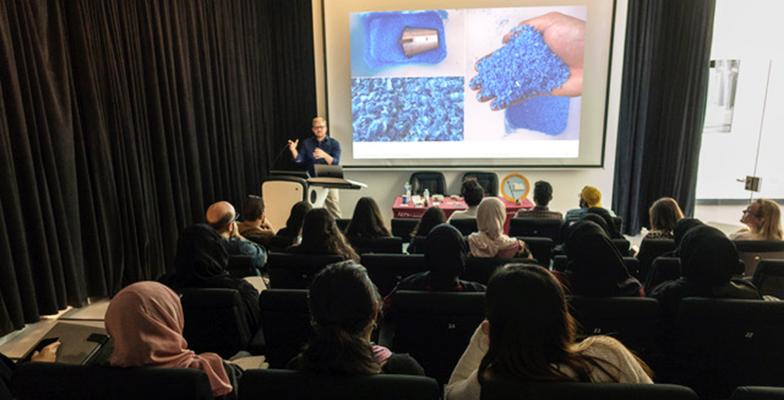 American University of Sharjah (AUS) Sustainability recently hosted the second lecture in its Sustainability Speaker Series. Felix Beck, Assistant Professor of Practice of Design at NYU Abu Dhabi (NYUAD), presented NYUAD’s Plastic Recycling Research Lab to a multidisciplinary group of AUS students and faculty members. The talk was driven by a call to fight the pollution from single-use plastic and start to see plastic as a precious resource with an extended lifecycle.
American University of Sharjah (AUS) Sustainability recently hosted the second lecture in its Sustainability Speaker Series. Felix Beck, Assistant Professor of Practice of Design at NYU Abu Dhabi (NYUAD), presented NYUAD’s Plastic Recycling Research Lab to a multidisciplinary group of AUS students and faculty members. The talk was driven by a call to fight the pollution from single-use plastic and start to see plastic as a precious resource with an extended lifecycle.Click here to read more.
-
Blue Building Technology Adopted at AUS, Energy and Water Savings at 80 Percent
-
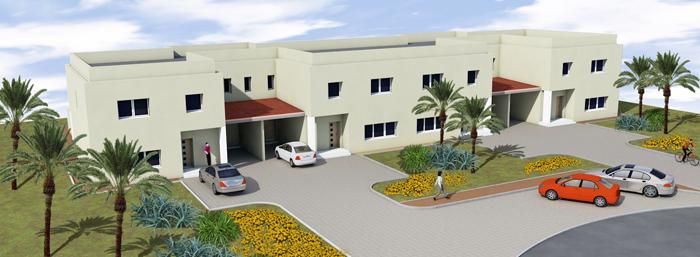 Modification works are being carried out on the first four villas built at the American University of Sharjah (AUS) in 1997 using Blue Building technology - creating up to 80 percent savings in water and energy consumption each year.
Modification works are being carried out on the first four villas built at the American University of Sharjah (AUS) in 1997 using Blue Building technology - creating up to 80 percent savings in water and energy consumption each year.Click here to read more.
- Smart Façades for Cooler Buildings in Sunny Climes
-

Window modules cast with fabric formwork would be non-repetitive in their geometry and adjustable to solar conditions to reduce heat gain.
High-rise residential buildings in the Gulf region require a high standard of energy efficiency due to the unforgiving desert climate. Jason Carlow, Associate Professor from the Department of Architecture, is currently researching how improving the environmental performance levels of façade systems would lower overall energy consumption.
“I’m investigating the fabrication of reconfigurable molds for casting architectural-scale concrete panels and façade modules,” he said. “These composite textile formworks can be reused for mass production and they also have the advantages of being more responsive and adaptive to curing concrete. The use of textiles in concrete formworks brings forward new opportunities for architectural forms and for new emerging structural systems in comparison with the very rigid formworks methods employed in the industry today.”
Carlow pointed out that prefabrication of concrete façade components is not new to the construction industry. However, many building regulations in rapidly developing cities have begun to promote the use of prefabricated, factory-cast concrete construction to reduce the amount of construction waste generated on construction sites, reduce the adverse environmental impact on sites, enhance the quality control of casting work and reduce the amount of site labor.

Study models and drawings for non-standard facade and window modules developed by Carlow.
Carlow will develop material prototypes in the Fabrication Laboratory in the College of Architecture, Art and Design (CAAD) to expand on his on-going research into production methods for variable, non-standard façade systems. As part of the investigation he will visit two leading fabric formwork research centers in the UK to discuss his research and production strategies with professors and casting specialists.
“This project will create and test strategies to radically increase the flexibility and performance of building façades through contemporary design and fabrication technologies,” explained Carlow. “By integrating higher energy performance into the design of building facades, buildings in extremely hot and sunny climates would be able to drastically lower overall energy consumption. In addition, embodied energy in the construction process could be significantly reduced by the reduction of construction waste with reusable, lightweight fabric forms.”
- Risk Assessment of 3D Printing in Construction Projects
-

The United Arab Emirates government is rapidly embracing new technology to develop a smart economy, with plans to have every new building in Dubai 25 percent 3D printed by 2025.
While there are many advantages in using 3D printing in the construction industry, a team of engineering professors at AUS explored the risks in order to help those involved, such as government agencies and designers, mitigate the pitfalls. “The main benefits of 3D printing in construction involve the ease of building and sustainability. It’s faster, costs less and shortens the supply chain,” explained Dr. Sameh El-Sayegh, Professor of Construction Management from the Department of Civil Engineering. “In terms of sustainability, we can build more eco-friendly structures with less waste and safer work sites.”
He and his colleague in the research, Dr. Lotfi Romdhane from the Department of Mechanical Engineering, examined the challenges facing this new technology through current literature and found that they were mainly related to the material used in construction. In addition, structural integrity and lack of codes and regulations were frequently cited as major challenges.
Construction projects are naturally risky endeavors as they involve the use of different materials and several project stakeholders with different objectives. The professors, along with Research Assistant Solair Manjikian, a recent civil engineering graduate, reviewed literature to investigate new risks in construction projects that use 3D printing and identified the 30 most probable risks.
These risks were grouped into six categories: material, equipment, design, construction, management, and regulatory and economic. They developed a survey to assess the probability and impact of the risks, which was completed by 37 respondents who had experience in 3D printing.
The risk priority was calculated using the fuzzy logic approach. The results showed that the main risks were a lack of codes and regulations, delay in government approval, a shortage of labor skilled in 3D printed construction, a lack of knowledge and information of 3D printed design concepts and changes in 3D construction codes and regulations.
“This research fills an identified gap in literature related to 3D printing in construction and provides insights into the key risks affecting this disruptive technology,” Dr. Romdhane pointed out. “These risks, if unmanaged, may hinder its successful implementation.”
The team has produced a paper based on their research, which has been published, by the Archives of Civil and Mechanical Engineering Journal. Dr. El-Sayegh said that the research outcomes would no doubt be beneficial to all involved in construction projects. “We would especially like to disseminate the results to government agencies, owners, designers, contractors, material suppliers and equipment manufacturers. The research in this emerging area will continue with students in the new Master of Science in Construction Management (MSCM) program, which will launch in Fall Semester 2020.”
- Exploring Sustainable Architectural Materials
-

Entitled “Where do the Twigs go?”— an image for the project commissioned by Dubai Design Week in 2018 to build a series of walls using paper pulp as a primary material.
Climate change challenges have led Faysal Tabbarah, Associate Professor in the Department of Architecture, to explore the new avenue of “architect as material developer” in devising sustainable materials for construction.
In researching, prototyping and analyzing the architectural potential of recyclable, environmentally friendly, sprayable, fibrous materials, he used pulped paper from old newspapers as a material for building construction beyond its typical usage as insulation. “As a result of my ongoing research in this area for some time, I was commissioned by Dubai Design Week in 2018 to build a series of walls using paper pulp as a primary material,” said Tabbarah. “It worked as a proof of concept to show that this kind of material could serve to augment or replace current materials that have a high environmental cost.”
Tabbarah pointed out that exploration of “architect as material developer” is increasingly relevant in contemporary architectural research going on in MIT’s Self-Assembly Lab and in the Institute of Computational Design and Construction at the University of Stuttgart.
Sustainable pulp is also becoming available for commercial use, such as eucalyptus tree fiber being used in the making of shoes by the Allbirds shoe company. Tabbarah has been working with the Sharjah-based environmental management company Bee’ah, which supplied him with plant material that the pulp material was sprayed on. “Previously, I worked with Bee’ah on exploring the architectural use of crumb rubber from the pulverizing of old tires, which culminated in a new approach to binding the rubber to give us a new material from which to design and manufacture furniture.”
Tabbarah will spend time away from the classroom working on a project comprising the building of walls, approximately 350 sqm, made of steel, reclaimed timber and paper pulp. He will then carry out scientific tests on the walls to see the effects of water, heat, compression and other factors in collaboration with colleagues in AUS’ Department of Mechanical Engineering.
“I will also spend the time exploring the relationship between sustainability, regional architectural discourse and the construction industry in the region, which connects with my teaching activities,” explained Tabbarah. “I intend the work to inform my development of courses in the design studio on sustainability and material development, which will open the door for cross-disciplinary research across architecture, engineering and construction, giving AUS students the opportunity of developing their ingenuity.”
- Environmentally Friendly Oil Refinery Waste Disposal
-

Spent caustic waste before and after treatment
The UAE’s thriving oil production of nearly four million barrels a day brings with it the responsibility of safely disposing of waste from its refining. In an effort to improve the treatment of this waste, a team of AUS professors have spent the last two years investigating the removal of phenolic compounds, the most difficult class of waste in terms of treatment and disposal. Having achieved a removal success rate by more than 99 percent, the race is on now to make the process industrially viable.
“The treatment of spent caustic waste from refineries and petrochemical industries is not only complex but also highly expensive due to the high chemical concentration of hazardous compounds, a high pH, variations in waste composition and the need to comply with environmental regulations,” said Dr. Taleb Ibrahim from the Department of Chemical Engineering. “Several existing technologies to treat one of the pollutants—phenolic compounds—require extreme operating conditions of pressure and temperature, which are neither environmentally friendly nor cost-effective.”
Dr. Ibrahim called on his colleagues in the department, Dr. Paul Nancarrow and Dr. Nabil Abdel Jabbar, along with Dr. Mustafa Khamis from the Department of Biology, Chemistry and Environmental Sciences, who carried out research on campus with the assistance of graduate student Muhammad Ashraf Sabri.
Using a real sample of caustic waste containing more than 1,000 components from a local oil refinery, the team focused on treating phenolic compounds in a simpler and environmentally friendly manner by using hydrophobic ionic liquids, which eventually proved successful. “Our research proved that what would have previously taken more than a day for the phenols to be fully flushed out, this process would now take just five minutes.”
A paper on the results of their work was published in the Journal of Industrial and Engineering Chemistry, entitled “Spent Caustic Treatment Using Hydrophobic Room-Temperature Ionic Liquids.”
However, work on the regeneration of the ionic liquids, necessary for the process to be industrially viable, was not as successful, so further research is underway. “In addition to physical experimentation, we’ll carry out computer modelling to test various hypotheses, which will help to reduce the time in the lab,” said Dr. Nancarrow.
The team, along with Muhammad Ashraf Sabri, who is now a research associate, will be joined at the end of the year by a post-doctoral researcher, Dr. Amir Sada Khan. They are also working closely with colleagues at Sultan Qaboos University in Oman, and at Queen’s University Belfast, which is a world’s leading center for research into ionic liquids.
“The second phase of the project involves modifying the surface of nanomaterials with ionic liquids so that phenolic compounds can become attached and then safely removed from the spent caustic waste,” explained Dr. Abdel Jabbar. “Early results show that this process allows the ionic liquids to be easily regenerated, giving us an environmentally friendly alternative to the conventional treatment technologies.”
Working closely on a research project requires scientists to have a good understanding not only of their discipline but of one another, and this team has a history of working very well together.
“We have been collaborating since 2012 and have co-authored more than 20 papers, so you could say we have a great understanding and respect for each other’s expertise,” said Dr. Khamis. “Our latest research project is a good example of interdisciplinary research for a real-world application.”
- The Philosophical Approach to Climate Change
-
 Many countries are now becoming aware of the effects of climate change worldwide and are seeking ways to curb damaging emissions. This concern has led Dr. Arianne Conty to teach environmental philosophy classes at AUS to raise awareness among students that anthropogenic climate change has pushed us into a new geological era called the Anthropocene.
Many countries are now becoming aware of the effects of climate change worldwide and are seeking ways to curb damaging emissions. This concern has led Dr. Arianne Conty to teach environmental philosophy classes at AUS to raise awareness among students that anthropogenic climate change has pushed us into a new geological era called the Anthropocene. Geologists have yet to confirm the exact date of the Anthropocene age—the start of human impact on the Earth’s geology and ecosystems—but the most popular dates are the mid-18th century Industrial Revolution or the more recent 1950s’ Great Acceleration. “Such a new era undermines the Western dichotomy between nature and culture, since mosquitoes are now DEET-resistant and there is a hole in the ozone layer,” said Dr. Conty, who explores the subject in her forthcoming book An Ecosophy for the Anthropocene Age.
It looks at the ways different academic responses from the natural and social sciences contradict each other. “How can we find solutions to climate change,” she asked, “if we cannot even agree on defining the problems, causes and consequences? We are at a critical time in mitigating the effects of climate change, and I hope that in pointing out the academic contradictions and exploring the ethical repercussions of the breakdown of the nature/culture divide, we can find a unified response.”
During her sabbatical, Dr. Conty was a visiting scholar in Rome at The Center for the Study and Documentation of Religious and Political Institutions in Post-Secular Society in the Università Roma III, where she had access to their specialized library to carry out research. While at the university, Dr. Conty presented her research at seminars and travelled to four conferences to present papers. She also had a paper on the Anthropocene published in the Environmental Values journal.
The center facilitated a private audience for Dr. Conty with His Holiness Pope Francis in the Vatican. “I was able to have a discussion with the Pope about a book he wrote in 2015 on the environment and the religious responses to the Anthropocene. It was such an honor to meet him!”
In addition to teaching environmental philosophy, Dr. Conty works closely with students on projects that seek to make AUS more sustainable. “The rapid rate of climate change is the most pressing issue that the world is facing right now, and students tend to feel helpless and depressed at the lack of action to reduce pollution and fund sustainable alternatives,” she said. “We were able to work with AUS Sustainability to visit the largest organic farm in the UAE and Sustainable City, so that students could find hope in the efforts of both individuals and governments in making a difference.”

- Protecting Sharjah's Blue Lagoons

Al Khalid Lagoon
Rising sea-levels due to climate change are a global problem that will have an impact on local communities. In response, Dr. Geórgenes Cavalcante and his colleagues Dr. Mohamed Abouleish, Dr. Serter Atabay and Filipe Vieira from American University of Sharjah are examining how Sharjah’s man-made lagoons may be affected in the future.
Pointing out how coastal lagoons are one of the most important assets in the Arabian Gulf region, Dr. Cavalcante said that Sharjah’s lagoons play an essential role in the emirate’s socio-economic environment. “Not only are they part of the smooth operation of the port and its maritime traffic, the lagoons are where many of Sharjah’s residents spend their leisure time, whether swimming or sailing, or at the restaurants overlooking the water.”
Originally coastal salt flats and two tidal creeks (khor in Arabic), dredging started on Khor Khalid and Khor Khan in the 1970s, which led to the digging out of a bay to form Khalid Lagoon. Some 20 years later, Al Khan and Al Mamzar lagoons were created. Today, a man-made sand spit divides Al Mamzar between the emirates of Sharjah and Dubai.
Due to their shallowness and narrow channels to the wider Gulf, the lagoons may experience this rise more immediately. “During our two-year project, we will apply numerical models to investigate how the sea-level rise will affect what’s known as the tidal prism, the volume of water in the lagoons between high and low tide,” said Dr. Cavalcante. “We will also evaluate the time that water remains in the lagoons before being flushed out and replaced with water coming in with the tides. And, more importantly, we will carry out a series of surveys to monitor water quality.”
A possible cumulative effect of the rise in sea-level in such semi-enclosed water bodies is the increase of water turbidity, or cloudiness, caused by the increase in sediment fluctuation in and out of the lagoons. This reduces the light penetration and subsequently the growth of food sources for sea life. It also accumulates on the sea floor, which can change its topography, thereby affecting water currents.
The AUS research team will start assessing the existing environmental data available on the lagoons, such as the currents, tides, weather, salinity, temperature, oxygen, density of particles, chlorophyll and nutrients. This will reveal trends in water quality conditions to help inform their research, which will entail field surveys and numerical simulation in order to explore present and future conditions, as well as the projected 100 years sea-level rise, based on scenarios by the Intergovernmental Panel on Climate Change.
Field observation studies on the actual variables will be conducted to compare them with the modelling results. Dr. Cavalcante said he was looking forward to taking his undergraduate students out onto the lagoons by boat as part of their studies on coastal systems. “It’s important that students have the opportunity to study the impact of natural and man-made effects on the ecosystem first-hand by learning field observation methods using state-of-the-art equipment.” Water quality sensors will measure water oxygen, salinity and temperature, while water movement sensors will study waves and currents.
Dr. Atabay will involve undergraduate and graduate students from the Department of Civil Engineering in data collection and in addressing concerns about the man-made structure supporting the lagoons. “This project will help us understand how the higher volumes of water and sediment, as a consequence of rising sea-levels, will have an impact on the structure,” he said. “The general findings will be disseminated as a student graduate project.”
The eventual results of the research team’s work will provide a comprehensive assessment of potential risks to water quality and also solutions in terms of the management of waste-water systems throughout the lagoons.
- Solar Park Study in Turkey
-

Soguksu Power Plant
The UAE is now home to the world’s largest single-site solar plant, which can cover the energy demand of 90,000 people. It’s part of the country’s Energy Strategy 2050 to increase the use of clean energy in an effort to reduce its carbon footprint. This focus on renewable energy systems by the UAE and elsewhere is giving impetus to its study in nearly all engineering fields.
In an effort to keep AUS’ programs on renewable energy relevant in this fast-changing industry, Dr. Mehmet Orhan from the Department of Mechanical Engineering is working with colleagues at Bursa Uludag University in his native Turkey. “The mechanical engineering faculty have access to research-scale laboratories and centers, and they have been carrying out research in this field for quite a long time,” he said. “I’ll have the opportunity to collaborate with them on various projects and will also be able to carry out practical research at the nearby Soguksu Solar Power Plant, as well as be involved in the design and construction of a new solar plant.”
Dr. Orhan teaches classes in renewable energy, fuel cells and hydrogen systems, in addition to the minor program in renewable energy, to mechanical, electrical and chemical engineering students. He explained how the minor program took a practical and hands-on approach to energy systems: “In the Energy Conservation and Management in Industry project, for instance, a team of four students goes out to an industrial facility and assesses potential energy-saving opportunities for a more efficient operation. They perform a detailed energy audit and then submit a report on the annual energy and cost savings and ROI.” The success of the students’ work-study has led to firms recruiting them to continue their projects as internships.
Dr. Orhan said his experience and observations in fully developed and well-equipped laboratories during his sabbatical will also be helpful in developing and equipping the new labs, especially the renewable energy lab, in the recently built AUS Engineering and Sciences building on campus.
In addition to assessing the performance of Soguksu Power Plant and the design of the new facility, Dr. Orhan will initiate new research collaboration in order to submit proposals to the European Union’s Horizon 2020, which is investing €30 billion in research and innovation projects.
- Sustainable Innovation to Improve the Healthcare Supply Chain
-

Healthcare is one of the seven priority sectors marked out by the UAE government for its National Innovation Strategy to help achieve UAE Vision 2021. Taking this further, AUS professors involved in supply chain management are exploring how hospitals can become more innovative in the context of sustainability for more environmental impact.
Dr. Abdulrahim Shamayleh from the Department of Industrial Engineering teamed up with Dr. Abdelkader Daghfous from the Department of Marketing and Information Systems, which runs the minor program in supply chain management, to carry out the research and also to spark interest among students in the minor program.
Dr. Shamayleh had conducted training courses earlier for the Dubai Health Authority’s procurement department on healthcare supply chain management. “The success of the program led to their request for research on a more sustainable process, and I had the opportunity of bringing in eight of our students to help carry out this project,” he said, adding, “it’s great to engage students in our research, as it’s not about us and really about giving them opportunities for real-world interaction.”
The first part of their two-year research project entails a systematic review of literature about sustainability in healthcare, with a focus on medical equipment and material supply chains. Dr. Daghfous explained that information was scattered at present: “We want to integrate what’s out there, uncover what’s missing and to help others investigate new avenues for research.”
The second phase will entail research in the field to build a framework for guiding healthcare professionals in formulating a strategy on sustainability-oriented innovation in their hospital or clinic.
Dr. Shamayleh said that he and his team of graduate students would meet with healthcare managers, specialists and government officials to investigate the obstacles they face and what they require to initiate a practice of sustainability-oriented innovation (SOI) in healthcare management. They then hope to develop case studies on up to 10 hospitals across the United Arab Emirates, which will lead to SOI initiatives that can be implemented, both locally and regionally.
They pointed out that sustainability in the healthcare supply chain included recycling medical equipment by refurbishing it and sending it to where it was needed, such as health authorities in impoverished countries, as an exercise in social responsibility.
Having done a lot of research into innovation over the past 25 years, Dr. Daghfous said he found that little had been done to enhance innovation in the healthcare supply chain. “This industry is so important, with huge environmental impact, that it’s vital to develop a model that would combine innovation with sustainability.”

